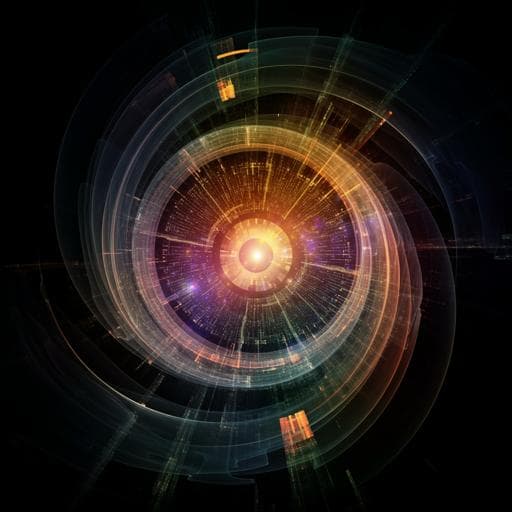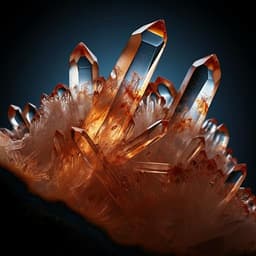
Engineering and Technology
Holographic multiplexing metasurface with twisted diffractive neural network
Z. Fan, C. Qian, et al.
This groundbreaking study introduces the metasurface disk concept, enhancing optical holographic storage with uncorrelated structural twists. By utilizing a twisted neural network model, we demonstrate how this innovative approach can store multiple high-fidelity images, paving the way for advancements in optical storage and computing. The research was conducted by Zhixiang Fan, Chao Qian, Yuetian Jia, Yiming Feng, Haoliang Qian, Er-Ping Li, Romain Fleury, and Hongsheng Chen.
~3 min • Beginner • English
Introduction
The paper addresses the challenge of storing the rapidly growing volume of data required for AI and human–machine interaction. Conventional magnetic/electronic planar storage suffers from high energy use, maintenance cost, and susceptibility to electromagnetic interference. Optical holographic storage offers volumetric storage by exploiting light’s properties (wavelength, polarization, OAM, angle) and advances in subwavelength photonic structures. However, despite early progress in metasurface-based display and encryption, achieving high-density, scalable holographic storage remains difficult due to complex experimental setups and constraints in photonic structure design. The authors propose a new approach—an optical metasurface disk (meta-disk) using structural twist—to break capacity limits and simplify multiplexed storage, aiming to significantly increase storage density while maintaining practical implementability.
Literature Review
The pursuit of high-density holographic storage has increasingly focused on multiplexing, which encodes multiple datasets that can be selectively accessed by varying illumination properties (angle, wavelength, polarization, OAM). Prior works in metasurface holography, angle multiplexing, and functionality multiplexing have demonstrated promise but face limitations from reliance on illumination changes, geometric optics approximations, and discrete-state overlays (e.g., cascaded/Moiré metasurfaces). These approaches typically provide limited functionality and scalability in complex scenes. The authors position structural twist between metasurface layers as an alternative, offering an additional, independent degree of freedom—twin diffraction domains—without requiring changes to incident light, thereby potentially overcoming prior bottlenecks in capacity and flexibility.
Methodology
Concept and architecture: The authors introduce a twisted diffractive neural network (TDNN), a physical neural network in which the weights are the interlayer twist angles between multiple metasurfaces (neuro-metasurfaces, NMs) arranged in layers. Each meta-atom acts as a neuron with complex transmission/reflection coefficients. Structural rotation between layers creates twin diffraction domains—morphologically similar diffraction regions whose effective interaction areas switch with twist—enabling multiple functionalities from a shared structure. By rotating one NM through angles α1, α2, …, αN, distinct diffraction domains M1, M2, …, MN are generated from an initial domain M0, providing additional design degrees of freedom.
Training and forward model: The propagation between layers is modeled with Rayleigh–Sommerfeld diffraction, accelerated via FFT. The layer-to-layer field update is U^{l+1} = F^{-1}( F(T^l U^l) H1 ), where H1 is the free-space transfer function, F denotes Fourier transform, and T^l is the NM scattering matrix. Twist can be applied to T^l (preferred to reduce error) rather than the complex field U^{l+1}. Forward propagation maps inputs to output-plane images across twin diffraction domains corresponding to different twist angles. The training objective minimizes a weighted average loss across domains using mean squared error (MSE) and correlation coefficient (CC), with gradients backpropagated to update NM transmission spectra.
Interpolation and lateral error handling: Matrix rotation in twist operations necessitates interpolation. The authors compare nearest-neighbor vs bilinear interpolation by reconstructing a reference (Rayleigh–Sommerfeld exact) output for a two-layer disk. Bilinear interpolation yields accuracy comparable to precise algorithms with minimal additional cost and higher CC (0.823 vs 0.814), and is adopted. Lateral errors and fabrication imperfections are modeled and analyzed to ensure robustness.
Fresnel number tuning: The Fresnel number F = a/(λ d) (a: period, λ: wavelength, d: interlayer spacing) governs interlayer coupling (one-to-one vs many-to-one mappings). Parameter sweeps identify performance regions; theoretical derivation suggests good performance for F in (2/N^2, 2/N) (N: lateral dimension in neuro-atoms). Practical choices are made to align with experimental constraints.
Pancharatnam–Berry (PB) metasurface design: To realize angle-independent phase control under circular polarization, PB phase modulation is used, introducing a geometric phase φ = −2θ (θ: in-plane nano-pillar rotation) with polarization conversion. Rectangular polymer nanopillars (n = 1.54) with high aspect ratio on SiO2 substrates are optimized (via RCWA and Jones calculus) for high cross-polarization conversion. For 3D laser printing simplicity, fixed dimensions are chosen (w = 320 nm, l = 640 nm, h = 3800 nm, period 1.25 μm, w/l = 0.5), with suggestions to further enhance diffraction efficiency by reducing spacing or varying transverse sizes.
Numerical demonstrations: Two-layer meta-disks (1000 μm interlayer spacing; each layer a circular disk of radius 256 neuro-atoms) store and reconstruct holographic videos (e.g., blooming flowers, lightning, butterfly). Temporal frames are mapped to continuous twist angles; reconstructions at 200×200 resolution are achieved with Δα = 5°/7.5° (and examples of 36 and 40 frames at 10°/9° intervals). The TDNN capacity, scalability, and multiplexing for orthogonal OAM images are assessed, including SSIM/PSNR-based crosstalk quantification.
Experimental fabrication and setup: Two 640 μm × 640 μm samples with 512 × 512 neuro-atoms are fabricated via two-photon polymerization 3D laser printing (Nanoscribe GT2; IP-Dip; 63×/1.40 NA objective; 60 mW; 6500 μm s−1; development in PGMEA 20 min, IPA 5 min, Novec 7100 2 min; air-dried; hatching 20 nm, slicing 100 nm; galvo scanning; 125 μm × 125 μm stitching fields). Optical setup: a linearly polarized laser is converted to circular polarization (quarter-wave plate), modulated by NM1, relayed via a custom objective and achromatic lens to adjust interlayer spacing and alignment, then modulated by NM2; output is captured on a CCD. Calibration modules align NM positions using LEDs and CCD feedback. Misalignment studies (z-axis, x/y shifts of 10 μm, rotational offsets) inform alignment tolerances via SSIM trends.
Error robustness and fabrication tolerance: Gaussian-distributed phase noise (σ) simulates fabrication errors. When σ < 30°, output correlation degrades modestly, indicating robustness. Rotational misalignment increasingly deteriorates reconstructions, emphasizing precise alignment.
Metrics and algorithms: The Methods provide explicit formulas for Fresnel diffraction via FFT, rotation coordinate transforms, nearest-neighbor and bilinear interpolation, MSE loss, and Pearson correlation coefficient. RCWA extracts S-parameters for conversion efficiency CE = |t_f/t_s|^2.
Key Findings
- Capacity and fidelity: A two-layer 640 μm × 640 μm meta-disk can store over hundreds of images with high fidelity; reported SSIM ≈ 0.8 (abstract). Numerically, two layers can efficiently store and retrieve up to ~100 images with high correlation (Fig. 3c).
- Video holography via twist: Two-layer systems reconstruct holographic videos by continuous twist. Demonstrations include 36 and 40 frames (rotation intervals 10° and 9°) and additional sequences at Δα = 5°/7.5°, achieving 200×200 output resolution.
- Interpolation accuracy: Bilinear interpolation outperforms nearest-neighbor in TDNN rotation handling with CC ≈ 0.823 vs 0.814 while maintaining computational efficiency.
- Error tolerance: With Gaussian phase noise simulating fabrication errors, image quality remains acceptable for σ up to ~30°; correlation degrades gradually with higher σ. Rotational misalignment reduces image quality, while improved alignment (distance/angle) increases SSIM.
- Scalability: Increasing layers from 2 to 4 and neuro-atom counts from 512×512 to 2048×2048 raises training correlation from 0.8577 to 0.9969, indicating strong scalability.
- Orthogonal multiplexing (OAM): A three-layer design achieves purity >80% for over 70 distinct OAM modes. For 70 modes (3-layer, 512×512), average SSIM ≈ 0.4062 and PSNR ≈ 12.3001, reflecting trade-offs between mode count and quality.
- Experimental validation: Fabricated PB meta-disks (640 μm × 640 μm, 512×512 cells) demonstrate dynamic focusing and lunar phase analogy on a CCD with rotation intervals Δω = 12°, 18°, 30°. The focal spot trajectory and full lunar phase progression are reconstructed.
- Multi-wavelength potential: Preliminary multiplexing across three wavelengths (Supplementary) demonstrates extensibility to frequency multiplexing.
- Design space: Twin diffraction domains and twist enlarge the design DoF beyond illumination-parameter multiplexing, enabling multifunctional, twist-selective responses without active illumination changes.
Discussion
The TDNN-powered meta-disk addresses the central challenge of scaling optical holographic storage by introducing structural twist as an independent multiplexing degree of freedom. Twin diffraction domains enable multiple, twist-selectable mappings from the same device, significantly enhancing storage density and flexibility compared to conventional angle/wavelength/polarization multiplexing alone. The combination of PB metasurfaces with FFT-based training provides a physically grounded, computationally tractable framework to design layered structures that reconstruct numerous images and videos from a compact, passive device. Numerical and experimental results validate the concept, showing high-capacity storage, twist-controlled video playback, and robustness to moderate fabrication errors. The approach is extensible: integrating twist multiplexing with wavelength and polarization multiplexing promises exponential capacity gains. Beyond storage and display, the TDNN framework supports broader photonic computing tasks, encryption, and multifunctional analog processing, potentially impacting VR, lens systems, communications (e.g., 6G), and quantum photonics. Future improvements will incorporate metasurface coupling (e.g., graph neural networks) for global design optimization, further enhancing reconstruction quality and functionality.
Conclusion
This work introduces the meta-disk and twisted diffractive neural network (TDNN) as a paradigm for high-capacity holographic storage using structural twist. By exploiting twin diffraction domains, the method achieves large design freedom and high multiplexing capacity, enabling storage of hundreds of images with high fidelity, twist-controlled holographic video, and orthogonal-mode generation. The authors validate the approach numerically and experimentally using PB metasurfaces fabricated via high-precision 3D laser printing. The technology provides a path toward next-generation optical storage, display, encryption, and analog photonic computing. Future research will focus on: (1) incorporating inter-metasurface coupling via graph neural networks for global optimization; (2) scaling device size and precision (centimeter-scale complex-amplitude metasurfaces); (3) combining twist with wavelength and polarization multiplexing for exponential capacity growth; and (4) mitigating alignment/mechanical errors through integrated packaging or programmable SLM-based implementations.
Limitations
- Experimental complexity and alignment: Reconstruction quality is sensitive to rotational and axial alignment; misalignments degrade SSIM. The current setup requires careful calibration with multiple optics and mechanical stages.
- Fabrication precision: Manufacturing imperfections (e.g., nano-pillar tolerances, stitching) and mechanical errors reduce image quality; hence simpler images were used for demonstrations.
- Coupling not fully modeled: The present TDNN largely neglects complex interlayer/meta-atom coupling; including coupling effects is planned via graph neural networks for improved fidelity.
- Trade-offs in capacity vs quality: As the number of stored images/modes increases, crosstalk rises (e.g., OAM experiments show average SSIM ~0.41 and PSNR ~12.3 for 70 modes), indicating a balance between quantity and quality.
- Throughput and scalability constraints: Current 3D printing throughput and device size limit resolution and field of view; higher-throughput fabrication or alternative platforms (e.g., SLMs) are needed for large-area, high-resolution deployment.
Related Publications
Explore these studies to deepen your understanding of the subject.







